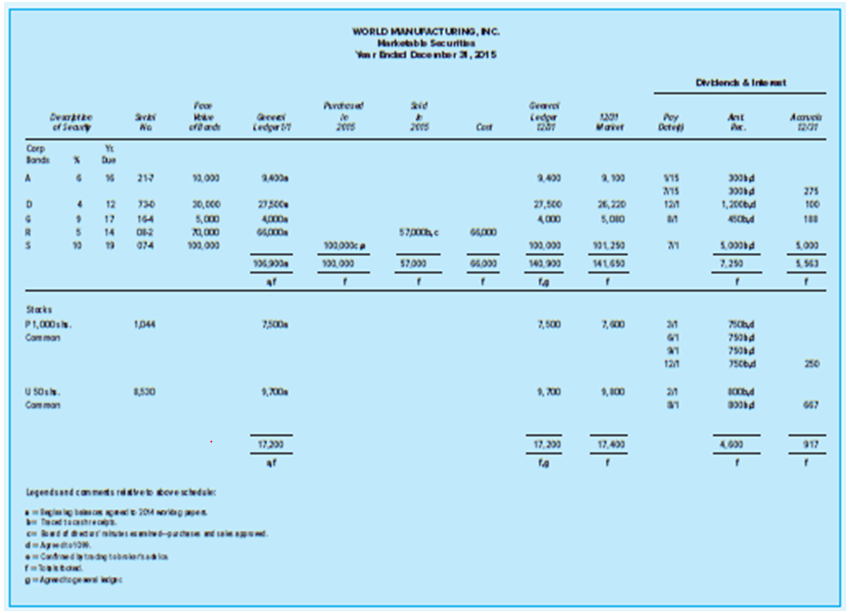Phung, CPA, has been engaged to audit the financial statements of Vernon Distributors, Inc., a continuing audit
Question:
Phung, CPA, has been engaged to audit the financial statements of Vernon Distributors, Inc., a continuing audit client, for the year ended September 30. After obtaining an understanding of Vernon's internal control system, Phung set control risk at the maximum level for all financial statement assertions concerning investments. Phung determined that Vernon is unable to exercise significant influence over any investee and none are related parties. Phung obtained from Vernon detailed analyses of its investments in domestic securities showing
∙ The classification among held-to-maturity, trading, and available-for- sale securities.
∙ A description of each security, including the interest rate and maturity date of bonds and the par value and dividend rate of stocks.
∙ A notation of the location of each security, either in the treasurer's safe or held by an independent custodian.

∙ The number of shares of stock or face value of bonds held at the beginning and end of the year.
∙ The beginning and ending balances at cost and at market, and the unamortized premium or discount on bonds.
∙ Additions to and sales from the portfolios for the year, including date, number of shares, face value of bonds, cost, proceeds, and realized gain or loss.
∙ Valuation allowances at the beginning and end of the year and changes therein.
∙ Accrued investment income for each investment at the beginning and end of the year, and income earned and collected during the year.
Phung then prepared the following partial audit program of substantive audit procedures:
1. Foot and crossfoot the analyses.
2. Trace the September 30 balances to the general ledger and financial statements.
3. Trace the beginning balances to the prior year's working papers.
4. Obtain positive confirmation of the investments held by any independent custodian as of the balance sheet date.
5. Determine that income from investments has been properly recorded as accrued or collected by reference to published sources, by computation, and by tracing to recorded amounts.
6. For investments in nonpublic entities, compare carrying value to information in the most recently available audited financial statements.
7. Determine that all transfers among held-to-maturity, trading, and available-forsale securities have been properly authorized and recorded.
8. Determine that any other-than-temporary decline in the price of an investment has been properly recorded.
Required:
a. For procedures 4-8, identify the primary financial statement assertion relative to investments that would be addressed by each procedure.
b. Describe three additional substantive auditing procedures Phung should consider in auditing Vernon's investments.
Financial statements are the standardized formats to present the financial information related to a business or an organization for its users. Financial statements contain the historical information as well as current period’s financial... Balance Sheet
Balance sheet is a statement of the financial position of a business that list all the assets, liabilities, and owner’s equity and shareholder’s equity at a particular point of time. A balance sheet is also called as a “statement of financial... Dividend
A dividend is a distribution of a portion of company’s earnings, decided and managed by the company’s board of directors, and paid to the shareholders. Dividends are given on the shares. It is a token reward paid to the shareholders for their... Face Value
Face value is a financial term used to describe the nominal or dollar value of a security, as stated by its issuer. For stocks, the face value is the original cost of the stock, as listed on the certificate. For bonds, it is the amount paid to the... Maturity
Maturity is the date on which the life of a transaction or financial instrument ends, after which it must either be renewed, or it will cease to exist. The term is commonly used for deposits, foreign exchange spot, and forward transactions, interest... Par Value
Par value is the face value of a bond. Par value is important for a bond or fixed-income instrument because it determines its maturity value as well as the dollar value of coupon payments. The market price of a bond may be above or below par,...
Step by Step Answer:

Auditing and Assurance Services A Systematic Approach
ISBN: 978-0077732509
10th edition
Authors: William Messier Jr, Steven Glover, Douglas Prawitt





